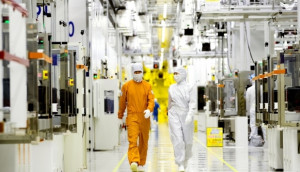
Because of the spread of COVID-19, companies need to expand their servers as many around the world are increasingly using teleworking, online education, and videoconferencing. And the demand for memory chips into the server has increased significantly.
Especially in Europe, demand for semiconductors will increase rapidly, and demand for smartphones and PCs will increase as well, because networks and servers are not properly deployed.
In the memory chip sector, companies continue to invest in the COVID-19.
In the past, the U.S. government has blocked the inflow of semiconductor technology into China by preventing the acquisition of Micron in the U.S. by Tsinghua Unigroup. The Chinese government has organized and operated special trains for employees of YMTC, a subsidiary of Tsinghua Unigroup, even after shutting down Wuhan, China on January 23. About 300 engineers who worked shifts at the factory have been on site for about a month after a one-week self-price period. The Chinese government temporarily lifted the labor regulations that prohibit the company from working more than 36 hours a month to operate the plant.
Samsung Electronics started mass-producing 5th generation NAND flash memories at its second plant in Xian, China on March 10 and is increasing its competitive edge in fine process by converting Pyeongtaek, Korea into a 6th generation NAND mass production system.
SK Hynix held a board meeting on April 2 and made a ‘money transfer decision’ to lend 3.2 trillion won to a Chinese corporation. The loan will be used for investment in facilities of the new plant in Wuxi, China, ‘C2F’s new plant. Currently, the C2F fab is producing DRAMs in about 70% of the total space, and this investment will be to fill the remaining 30% of the total. SK Hynix’s latest investment is seen as a decision made in anticipation of increased demand for DRAMs for servers and mobile devices.
Many companies are investing in the system semiconductor sector as well.
Chengdu City, Sichuan Province in China recently held a groundbreaking ceremony for a large-scale semiconductor research complex as part of its ‘Integrated Circuit Focus’ project and will invest 12 billion yuan ($2.13 trillion). The company plans to carry out eight major system semiconductor business here, including development of MEMS (Microelectronic Control Technology) and IP (System Semiconductor Core Design Asset) and support businesses.
Hefei City, Anhui Province in China also announced that a new 12-inch fab will be built by Israeli foundry company Tower Jazz.
Recently, SK Hynix acquired Korea’s Magna Chip from a fund that participated as an investor. Magna Chip was created in 2004 as part of Hynix’s restructuring by spinning off its non-memory operations, and was listed on the New York Stock Exchange in 2011 and succeeded in making a comeback. Magna Chip ranks second in the display driver IC (DDI) market, a semiconductor that drives OLED displays.
Authorities warn that the consequences of such a shift will become apparent as the working population will be unable to maintain living standards for the dependent population due to the increased burdens associated with an ever diminishing workforce.
Mike Choi
Asia Journal
(Los Angeles Times Advertising Supplement)

